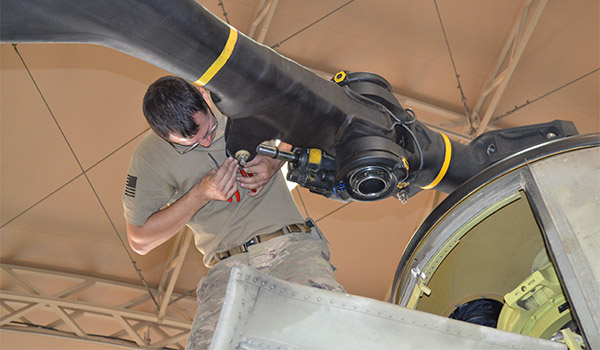
Branch Chief’s Corner / By MG David J. Francis: As a nation, we rely on our ability to project power from the Continental United States and globally integrate the Joint Force’s actions.

U.S. Army SPC Jedidiah Gaddie, CH-47 helicopter repairer with Bravo Company, 628th Aviation Support Battalion, 28th Expeditionary Combat Aviation Brigade performs routine maintenance on a CH-47 Chinook helicopter at an airfield in the 28th ECAB’s area of operations in the Middle East./ U.S. ARMY PHOTO BY SPC JOYCE AVILA-COLLAZO
The Army requires that we establish and train as an expeditionary force capable of executing a series of rapidly and continuously integrated options across all warfare domains. For Army Aviation, this shapes the modernization effort for our core/enduring required capabilities (RCs), comprising three general categories: 1) Reconnaissance and security, 2) Air assault, air movement, and aeromedical evacuation, and 3) Attack, close support (to include interdiction, Electronic Warfare).
Accompanying our core capabilities are three enabling RCs: 1) Ensure aircraft and aircrew survivability, 2) Sustain and maintain aviation operations, and 3) Support of C2. While Aviation RCs will remain relatively constant over time, each RC’s underlying tasks, conditions, and standards will not. Historically, as technology innovates and matures and as adversaries do the same, our approach to providing these fundamental capabilities to the Army changes as well. This results in an ever-developing set of tasks, conditions, and standards required to maintain overmatch with our adversaries via improved reach, survivability, lethality, and sustainment.
The doctrinal context that defines the environment in which we must provide these capabilities is how we will execute our mission sets in a decentralized manner while dispersed for prolonged periods from austere locations with limited resupply and a reduced sustainment footprint. This is the approach we are taking with the Future Attack Reconnaissance Aircraft (FARA), Future Long-Range Assault Aircraft (FLRAA), and Future Tactical Unmanned Aircraft Systems (FTUAS).
As we continue to refine the requirements for the fight we are expecting, we have to focus on both the ability to fight them and the ability to sustain them. This linkage between the two begins when a capability gap is recognized, and the requirements are defined. Building the system and sustaining the system must be aligned from the start; if it is not sustainable, it will always lag behind.
The Concept
As we move forward and build an expeditionary sustainment system for the current fleet and Future Vertical Lift (FVL), there must be an overarching approach that encompasses all fleets. Our newly released U.S. Army Concept for Aviation 2028 delves into these topics in-depth and covers: Reduced Logistics Footprint; Increased Organic Capability; Improved Operational Capability; and Decreased Life-Cycle Costs.
A reduced logistics footprint is essential for several reasons. First, a reduced logistics footprint will reduce the ‘signature’ of Aviation units, making them harder to detect (and target). Second, a reduced logistics footprint will reduce the demand on transportation assets (in delivering the supplies/equipment/personnel to the unit and moving supplies/equipment/personnel with the unit). The reduction in transportation demand, in turn, returns a relative degree of mobility to the unit, thereby enhancing survivability and the ability to operate dispersed. Third, a reduced logistics footprint will preclude wastage and/or mal-positioning of supplies/equipment/personnel. Aviation sustainment will achieve a reduced logistics footprint through the aggregate effect of a number of initiatives.
Increased Organic Capability will drive Army Aviation towards commonality in maintenance procedures, tools, and parts among various missions, designs, and a series of enduring fleets and Future Vertical Lift aircraft. Aviation maintainers will also leverage advanced technology for cognitive aiding and virtual instruction on maintenance tasks at the point of need to broaden capability further and improve capacity. Aviation sustainment elements must have an improved degree of mobility on the future battlefield.
Improved Operational Availability addresses the ability to meet the demands of the scale, scope, and tempo of large-scale multi-domain operations. Army Aviation must have improved operational and materiel availability in its aircraft and critical mission systems.
All the efforts outlined above will contribute to decreased life-cycle costs for Army Aviation systems. Getting the right ‘balance’ between up-front procurement costs and long-term sustainment costs requires careful analysis and decision making from the program outset.
AMCOM has done an exceptional job laying out the expeditionary sustainment roadmap for Army Aviation in 2028 and is the lead for the Aviation Enterprise. It is up to the rest of the Enterprise to embrace this concept as we provide more effective and integrated approaches to facilitate the employment of Army Aviation, the Army as a whole, and the Joint Force in order to win on the battlefield of tomorrow and 2028 because winning matters!
Above the Best!
MG David J. Francis is the Army Aviation branch chief and commander of the U.S. Army Aviation Center of Excellence and Fort Rucker, AL.







